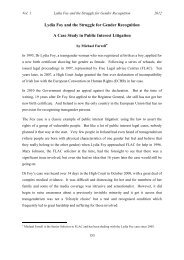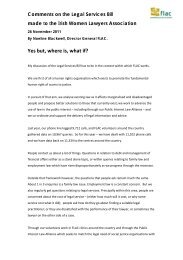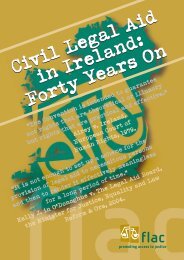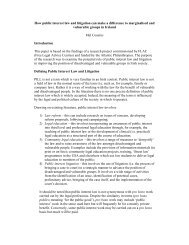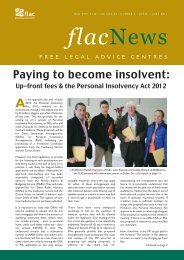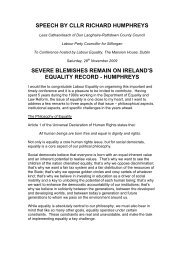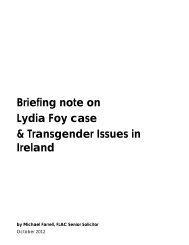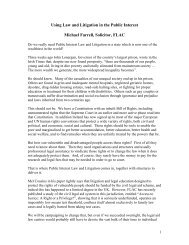Public Interest Litigation as a Tool for Vulnerable Groups: Lessons ...
Public Interest Litigation as a Tool for Vulnerable Groups: Lessons ...
Public Interest Litigation as a Tool for Vulnerable Groups: Lessons ...
You also want an ePaper? Increase the reach of your titles
YUMPU automatically turns print PDFs into web optimized ePapers that Google loves.
II. <strong>Public</strong> <strong>Interest</strong> <strong>Litigation</strong> in Practice: Some InsightsSangeeta Ahuja’s two volumes studying public interest litigation in India areworthy of detailed study <strong>for</strong> the range of c<strong>as</strong>es that have been addressedthrough this mechanism. In this section a few examples have been chosen toillustrate the manner in which the Courts have dealt with issues and tohighlight their outcome.In Hira Lal and anr v Zilla Parishad, Kanpur and ors, 23 a petition on behalf ofScheduled C<strong>as</strong>tes employed in the fraying of carc<strong>as</strong>ses, resulted in a sociolegalinvestigation into the industry and finally suggestions from the Court tothe state government towards an improvement of the socio-economic plightof the workers in the industry. Similarly in Sanjit Roy v State of Raj<strong>as</strong>than 24exceptions to minimum wage (affecting mainly SC/ST workers) designed bythe Raj<strong>as</strong>than Famine Relief Work Employees (Exemption from Labour Laws)Act 1964 were repealed.According to studies, 86.6 per cent of bonded labourers come from amongthe Dalit and Tribal population. 25 Several c<strong>as</strong>es concerning bonded labourhave come be<strong>for</strong>e the Supreme Court under the Bonded Labour System(Abolition) Act, 1976. 26 While a remedy <strong>for</strong> bonded labour w<strong>as</strong> provided in theAct, it w<strong>as</strong> not until social action groups challenged its occurrence that thelegislation began to take effect. Journalists and public service organisations,rather than the labourers (most of whom were unaware their situation w<strong>as</strong> inviolation of law) moved the Court to repeal this ‘structurally entrenchedproblem’.27 Several c<strong>as</strong>es on the issue have come be<strong>for</strong>e the courts, raisingthe possibility of dismantling this age-old phenomenon. 2823 1982 (1) SCALE 123 [545].24 AIR 1983 SC 328, the action taken by the Social Work and Research Centre, in Raj<strong>as</strong>than (anorganisation working <strong>for</strong> the upliftment of SC/ST) complained against the <strong>Public</strong> Works Department’sviolation of the provisions of the Minimum Wages Act, 1948.25 Scheduled C<strong>as</strong>tes account <strong>for</strong> 61.5 percent while Scheduled Tribes account <strong>for</strong> 25.1 per cent of thetotal bonded labourers. See Ahuja (1997) (n 164 above) 300.26 s2(g) defines bonded labour <strong>as</strong> being in existence when the following conditions are satisfied: (i) inconsideration of an advance obtained by him or by any of his lineal descendants (whether or not suchadvance is evidenced by any document) and in consideration of the interest, if any, due on suchadvance or (ii) in pursuance of any customary social obligation, or (iii) in pursuance of an obligationdevolving on him by succession, or (iv) <strong>for</strong> any economic consideration received by him or by any ofhis lineal <strong>as</strong>cendants or descendants, or (v) by re<strong>as</strong>on of his birth in any particular c<strong>as</strong>te of community,he would – (1) render, by himself, or through any member of his family, or any person dependent onhim, labour or service to the creditor, <strong>for</strong> a specified period or <strong>for</strong> an unspecified period, either throughwages or <strong>for</strong> nominal wages, or; (2) <strong>for</strong>feit the freedom of employment or other means of livelihood <strong>for</strong>a specified period or <strong>for</strong> an unspecified period, or; (3) <strong>for</strong>feit the right to move freely throughout theterritory of India, or (4) <strong>for</strong>feit the right to appropriate or sell at market value any of his property orproduct of his labour or the labour of a member of his family or any person dependent upon him.27 Ahuja (1997) (n 164 above) 300.28 Bandhua Mukti Morcha v State of Tamil Nadu, 1986 (Supp) SCC 541; Bandhua Mukti Morcha vUnion of India and ors (Haryana Mines I), AIR 1984 SC 802/(1984) 4 SCC 161, 1991 (1) SCALE 79[295], AIR 1992 SC 38; Bandhua Mukti Morcha, through Chairman, Swami Agnivesh v State ofHaryana and ors (Haryana Mines II), 1983 (1) SCALE 121 [543]; Vivek Pandit v State of Mahar<strong>as</strong>htraWP No. 1503 of 1984; Vivek Pandit v State of Makar<strong>as</strong>htra WP No. 1504 of 1984; ChattisgarhKrishak Mazdoor Sangh v State of MP and others WP No. 13300 of 1983; Upendra and ors v State ofMP and anr WP (Civil/Cri) No 1071 of 1986 among others.6



